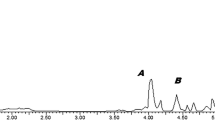Abstract
In contrast to previous results from laboratory rats, when sexual dimorphism occurred, clitoral glands from wild female rats were heavier and accounted for a greater proportion of body mass than preputial glands from wild males. Gland length and weight increased with body weight, but gland weight as a proportion of body weight did not. Preputial and clitoral glands showed seasonal differences in size: at one site glands were smaller in December than in April. Maturity, estrus, and pregnancy had no significant effect on clitoral gland size, but immature males had proportionally smaller preputial glands than mature males, and the absolute gland weight, but not gland weight as a proportion of body weight, increased with testes weight. There were no differences between the sexes in lipid production, which increased with preputial or clitoral gland weight. An homologous series of aliphatic acids and their methyl and ethyl esters, plus squalene, cholesterol and lanosterol, was revealed by GC-MS study of the trimethyl silyl derivatized lipid extract. Males and females could be distinguished by principal component analysis of chromatogram peaks.
Similar content being viewed by others
References
Albone, E.S. 1984. Mammalian Semiochemistry. Wiley Interscience, Chichester.
Berdoy, M., andMacdonald, D.W. 1991. Factors affecting feeding in wild rats.Acta Oecol. 12:261–279.
Brouette-Lahlou, I., andVernet-Maury, E. 1990. Amniotic fluid and dodecyl propionate pheromone: Influence on the onset and regulation of maternal anogenital licking in the rat, pp. 276–281,in D.W. Macdonald, D. Müller-Schwarze, and S.E. Natynczuk (eds.). Chemical Signals in Vertebrates 5. Oxford University Press, Oxford.
Brown, R.E. 1985. The Rodents. II: Suborder Myomorpha, pp. 345–417,in R.E. Brown and D.W. Macdonald (eds.). Social Odours in Mammals. Clarendon Press, Oxford.
Christie, W.W. 1982. Lipid Analysis, 2nd ed. Pergamon Press, Oxford.
Clevedon Brown, J., andWilliams, J.D. 1972. The rodent preputial gland.Mammal Rev. 2:105–147.
Ebling, F.J. 1977. Hormonal control of mammalian skin glands, pp. 17–33,in D. Müller-Schwarze and M.M. Mozell (eds.). Chemical Signals in Vertebrates 1. Plenum, New York.
Ebling, F.J., Ebling, E., Randall, V., andSkinner, J. 1975. The synergistic action of α-MSH and testosterone on the sebaceous, prostate, preputial, Harderian and lachrymal glands and brown adipose tissue in hypophysectomized rats.J. Endocrinol. 66:407–412.
Fenn, M.G.P. 1989. Ecology of the Norway rat (Rattus norvegicus) on lowland farms in England. DPhil thesis. Oxford University.
Gawienowski, A.M., Orslak, P.J., Stacewicz-Sapuntzakis, M., andJoseph, B. 1975. Presence of sex pheromone in preputial gland of male rats.Endocrinol. 67:283–288.
Gawienowski, A.M., Orslak, P.J., Stacewicz-Sapuntzakis, M., andPratt, J.J. 1976. Attractant effect of female preputial gland extracts in the male rat.Psychoneuroendocrinology 1:411–418.
Orslak, P.J., andGawienowski, A.M. 1972. Olfactory preferences for the rat preputial gland.Biol. Reprod. 6:219–223.
SAS. 1985. Statistical Analysis System. SAS Institute Inc., SAS Circle, Box 8000, Cary, North Carolina 27512-8000.
Smith, E.L., Hill, R.L., Lehman, I.R., Lefkowitz, R.J., Handler, P., andWhite, A. 1983. Principles of Biochemistry: Mammalian Biochemistry, 7th ed. McGraw-Hill, International Student Edition, London.
Stacewicz-Sapuntzakis, M., andGawienowski, A.M. 1977. Rat olfactory response to aliphatic acetates.J. Chem. Ecol. 3:411–417.
Stockley, P., Searle, J.B., Macdonald, D.W., andJones, C.S. 1994. Alternative reproductive tactics in male common shrews: Relationships between mate searching behaviour, sperm production and reproductive success as revealed by DNA fingerprinting.Behav. Ecol. Sociobiol. 34:71–78.
Thody, A.J., andDijkstra, H. 1978. Effect of ovarian steroids on preputial gland odours in the female rat.J. Endocrinol. 77:397–404.
Zarrow, M.X., Yochim, J.M., andMcCarthy, J.L. 1964. Experimental Endocrinology. Academic Press, New York.
Author information
Authors and Affiliations
Rights and permissions
About this article
Cite this article
Natynczuk, S.E., Macdonald, D.W. & Tattersall, F.H. Morphology and chemistry of brown rat,Rattus norvegicus, preputial and clitoral glands. J Chem Ecol 21, 247–260 (1995). https://doi.org/10.1007/BF02036655
Received:
Accepted:
Issue Date:
DOI: https://doi.org/10.1007/BF02036655




